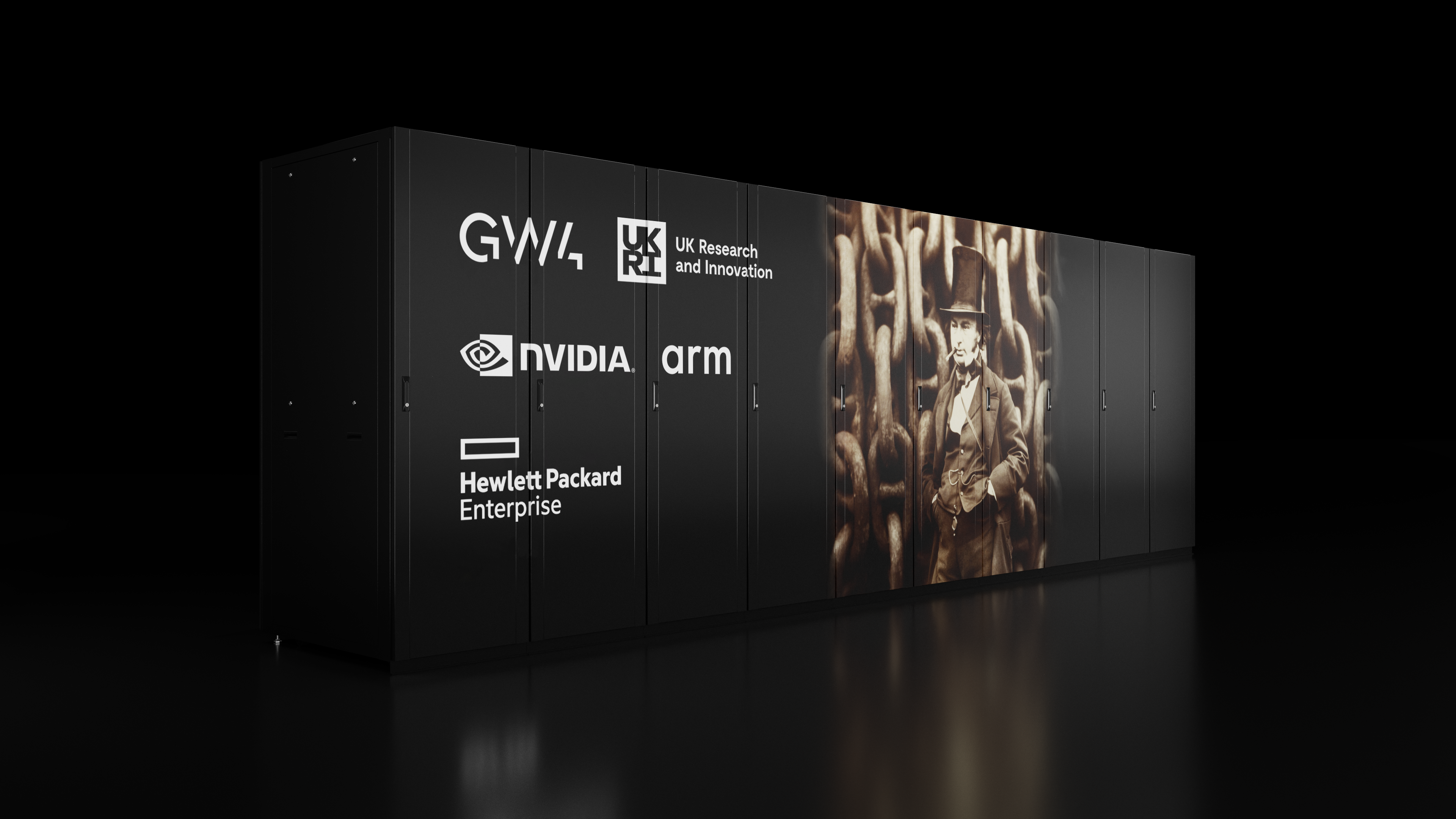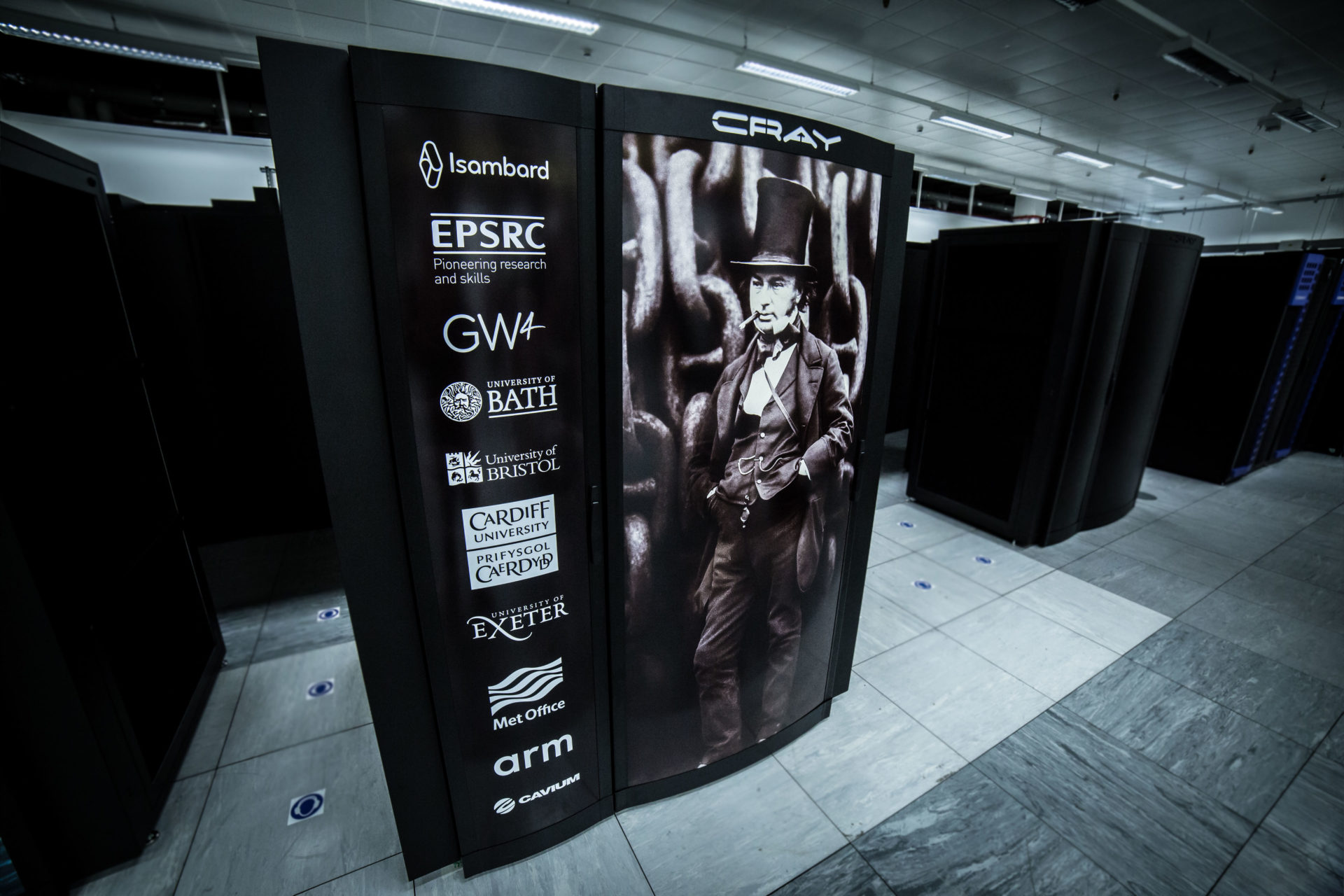GW4 Isambard is the world’s first Arm-based supercomputer to go into production use, and the largest Arm-based system outside of the U.S.
Since 2016, there has been a total investment in GW4 Isambard of over £17 million from UK Research and Innovation. Through this investment, Isambard is an award winning, internationally leading service, with over 800 registered users from across the Alliance and around the world, including industry partners.
AMBITIOUS PROJECT
The GW4 Alliance, together with global supercomputer leader Cray Inc. and the Met Office, was originally awarded £3m by the Engineering and Physical Sciences Research Council (EPSRC) in 2016 to deliver a new Tier 2 high performance computing (HPC) service for scientists. This unique new facility was named ‘Isambard’ after the renowned Victorian engineer Isambard Kingdom Brunel.
Through the GW4 Alliance network researchers and scientists from different disciplines were able to collaborate with our partners to design the supercomputer and achieve something that would not have been possible as individual institutions.
Due to the success of Isambard, GW4 and our partners secured a further £4.1m from EPSRC in February 2020 to create Isambard 2, the largest Arm-based supercomputer in Europe. In May 2023 GW4 were awarded an additional £10 million by UK Research and Innovation (UKRI) to develop Isambard 3, creating a new, TOP500-class supercomputer service for AI and high-performance computing (HPC).
This ambitious project exemplifies university-industry collaboration and the world-leading capability of the South West England and South East Wales region in advanced engineering and digital innovation.
SCIENTIFIC BREAKTHROUGHS
The GW4 Isambard project initially set out to prove that a new Arm-based technology was relevant to supercomputing. Arm develop the processors found in most mobile phones and tablets but until GW4 Isambard had never been used in servers or supercomputers before. Isambard 1 included over 10,000, high-performance 64-bit ARM cores, making it one of the largest machines of its kind anywhere in the world.
Isambard 3 continues to push scientific and technological boundaries and will utilise the latest novel technologies, including the new Arm®Neoverse™-based NVIDIA Grace CPU Superchip, to provide a production system of at least 55,000 cores. The new system - one of the first in the world based on NVIDIA Grace - will have more than six times the computational performance and six times the energy efficiency of Isambard 2.
Supercomputers enable researchers to tackle large scale problems that would not be possible on other machines. Initially hosted by the Met Office to develop more sophisticated weather forecasting and climate prediction modelling, Isambard has also been used to investigate next-generation healthcare and to develop innovations in medicine. Researchers are running molecular level simulations to understand the mechanisms behind Parkinson’s disease, and to help develop new drugs to treat osteoporosis. Research conducted on Isambard was also vital in the fight against COVID-19, contributing to the design of the vaccines by modelling the virus and how vaccines might work against it.
Dr Paul Selwood, Principal Fellow in Supercomputing at the Met Office said: “Isambard has been of great value to the Met Office, providing an excellent platform to develop our next generation weather and climate models.”
Isambard 3’s significantly upgraded performance will enable new research in a wide range of areas, including in clean energy, modelling optimal configuration of wind farms on both land and water, and modelling fusion reactors to provide green energy in the future. The new collaboration with NVIDIA will also enable Isambard to support cutting-edge research in AI and machine learning. Isambard 3 will also support new user communities from AI, life sciences, medical, astrophysics and biotech.
INTERNATIONAL SUCCESS
The GW4 Alliance was shortlisted under the category of Technological Innovation of the Year at the Times Higher Education (THE) Awards in 2017 for our world-first supercomputer, Isambard. The THE Awards are often called the Oscars of the higher education sector, attracting hundreds of entries each year from UK universities, honouring creativity, efficiency, and innovation.
At the long-standing Cray User Group conference in Montréal, May 2019, the Isambard benchmarking paper was awarded the Best Paper prize. The Isambard paper beat off high-quality submissions from top HPC sites around the world, including all the large HPC labs in the USA, Europe and Asia.
Isambard has had a significant international impact, being the first production supercomputer based on Arm CPUs. As such, it has received a lot of positive PR, and our software and benchmarking activities have made major contributions to the UK and international communities. Isambard is regarded as one of a few key systems that is changing the face of HPC. A recent article on The Next Platform stated Isambard was second in the world only to the ‘Astra’ Arm-based system at Sandia, a machine 15 times larger than Isambard. (Astra has since commenced classified operation, leaving Isambard as the leading open-science Arm-based service in the world today).
With over 800 users from all over the world, Isambard is already one of the most widely used Tier 2 systems. The GW4 Isambard team ran their first hackathon at Cray’s UK headquarters in Bristol in November 2017. The event attracted over 30 software developers from across GW4, the Met Office and Cray, as well as international institutions. Significant technical progress was achieved, and since then Isambard has been a great enabler of advanced tutorials for GPU programming and porting to Arm.
Members of the Isambard team have been invited to speak at international conferences about the GW4 Isambard project and what science it is yielding. The GW4 Isambard PI, Professor Simon McIntosh-Smith was invited to give the only keynote from an external speaker at the Arm Partner Meeting in 2019.
NEW TECHNOLOGIES
Isambard 1 was a Cray XC50 system with Marvell ThunderX2™ processors based on the 64-bit ARMv8-A architecture. Isambard 2 doubled the size of Isambard to 21,504 high performance cores and 336 nodes. Isambard 2 also incorporated the latest novel technologies from HPE and new partner Fujitsu, including next-generation Arm CPUs in one of the world’s first A64fx machines from Fujitsu. With significantly increased efficiency, capacity and eight times more memory bandwidth, Fujitsu’s A64fx Arm-based processor Isambard 2 pushed the frontiers of scientific research by supporting the development of powerful new algorithms, paving the way for sophisticated climate modelling and medical research.
Isambard 3 will utilise a new NVIDIA Grace-based Arm production system of at least 55,000 cores to enable at-scale experiments and meet projected demand over the next four years, making it one of the top 500 supercomputers in the world.
Professor Simon McIntosh-Smith, Principal Investigator for the GW4 Isambard project and a Professor of high-performance computing at the University of Bristol, said: “Isambard is already pushing the boundaries of scientific research, with significant developments being made that just wouldn’t be possible without it. Isambard 3 will create several ‘world-firsts,’ and the new Arm-based NVIDIA Grace processors will enable new kinds of research and innovation in artificial intelligence and scientific simulations.
“Isambard 3 will provide researchers across the UK and internationally access to cutting-edge technology, with a transformational increase in performance and energy efficiency. It’s a great vehicle for supporting collaborations with our academic and industrial partners all over the world.”
SUPPORT AND ACCESS
For more information visit the GW4 Isambard User Guide or email isambard-support@gw4.ac.uk









